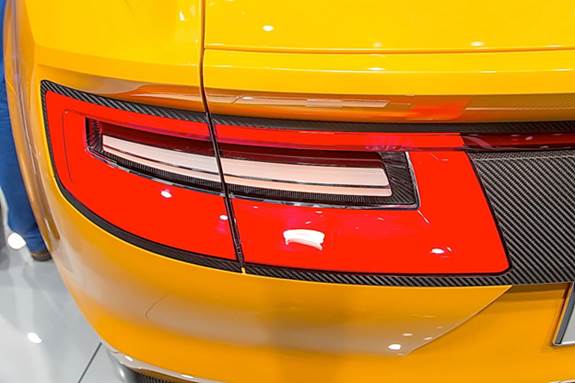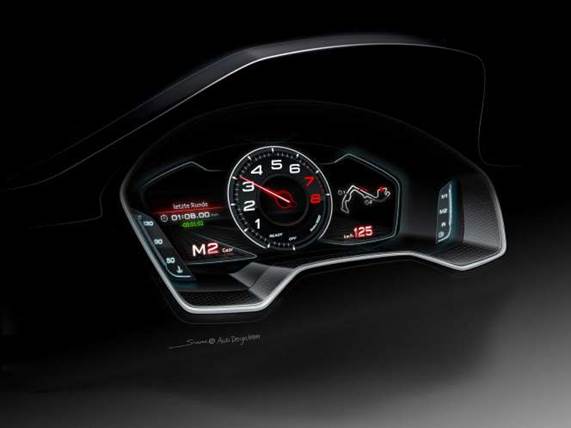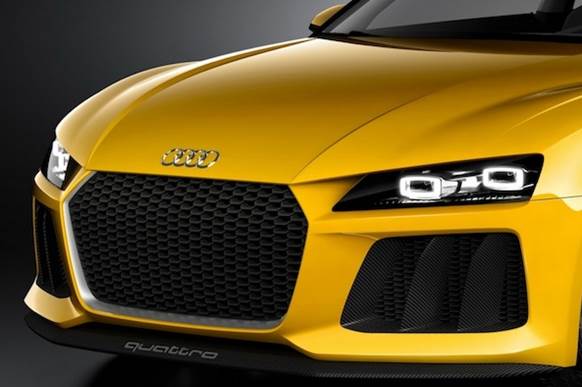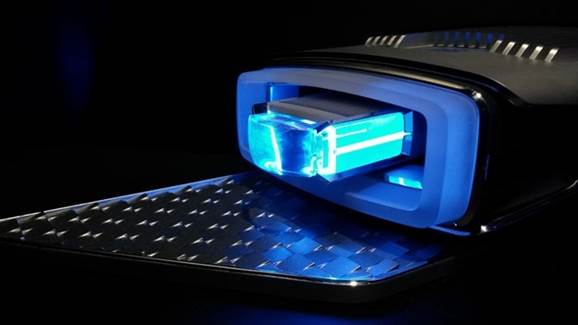Most concepts are cramped compromises, but the F13 is different. Even though the rear passenger compartment is no roomier than that of the A5, driver and passenger enjoy the spaciousness of an A7. Despite the wide C-posts, which look like a curious blend of generic Quattro and Camaro cues from certain angles, the all-round visibility is good. The relatively wide transmission tunnel accommodates the larger of two battery packs. The other one is installed transversely below the rear seats. Next to the transmission lever, there is an inductive charging slot for mobile phones and an array of six pre-select buttons where one can store favorite destinations, phone numbers, radio stations and vehicle settings. Below the electric parking brake there is the latest version of MMI touch, but the main ergonomic innovation is the re-designed multi-functional steering-wheel, which houses new features such as hydraulic front axle lift, additional surround-view perspectives and a stopwatch/lap timer. Not a day too soon, Drive Select has been moved from the MMI level to within easy reach of the driver’s left thumb. Next to it, a Sport button automatically sharpens the car’s six senses. Adjacent to the red start/stop button, a smaller knob, labeled EV, turns the Sport Quattro into a zero-emission vehicle.

Sadly, since this is a pre-prototype, the hybrid system isn’t actually working. Although the F13 is equipped with a full stack of energy cells, the sorry state of charge permits no more than crawling pace. In theory the lithium-ion batteries can store up to 14.1 kWh and the electric motor, which is an integral element of the eight-speed automatic gearbox, develops 150 PS and 400 Nm of instant torque. That’s instant as in ‘Smokey-and-the-Bandit burnout with ESP and ASR deactivated’ instant. The driving range in zero-emission mode is 48 kilometers, and since the e-motor is part of the gearbox, it propels all four wheels at all times. At this point in time, however, the only available source of propulsion is the melodious twin-turbo V8. Taken straight out of the RS7, the 4.0-liter unit dishes up 560 PS between 5,700 and 6,600 RPM. The maximum torque of 700 Nm is available all the way from 1,750 to 5,500 RPM. The two twin-scroll chargers are supported by two intercoolers and by a switchable thin-wall free-flow exhaust, which voices its state of mind through two large tailpipes.

Charging the plug-in hybrid through a bespoke wall-box is said to take less than two hours. In the real thing, there will be three driving modes to choose from: Electric, Hybrid and Sport. In Electric, the performance is relatively modest, but as soon as you depress the accelerator past a deterrent, the V8 automatically cuts in. The Hybrid program taps the GPS for real-time data such as traffic, topography and route selection. It is possible to complete certain sections of the route in EV mode or to charge the batteries on the move to save enough emission-free miles for the silent approach to home. In Sport, the car delivers maximum performance, which includes an electric boost function. With the energy pack fully charged and the throttle nailed to the firewall, the reincarnation of the Ur Quattro can zoom to an impressive top speed of 307 km/h. Fuel economy? When put through the unrealistic NEF cycle, F13 averages a highly theoretical 40.2 km/l, which equals 59g CO2/km. The real-life consumption is said to be closer to the 19.5 km/l mark.
Stepping out of the re-bodied and re-engineered RS7 into the 1984 Sport Quattro makes for a very special type of time travel. Our journey through the cabin begins with the forgotten world of the dual-purpose steering wheel, which can sound the horn and change direction, but not play music, answer the phone, scroll through sub-menus or deploy an airbag. The instruments, too, are of the minimalistic kind. Speedometer and rev counter both, of course, analogue with white-on-black dials frame a set of 16 tell-tales. In the other car the display is digital and 3D, fully animated in many colors, and able to summon special information such as racetrack layouts, section times to beat and driving ranges in Hybrid or Electric mode. Air is conditioned by fingertip controls, light is dispatched via matrix beam technology, gears are changed by an electronic brain. Not so in the vintage Audi, which works your left foot and your right hand, employs halogen candles to see through the night and adjusts the cockpit temperature via old-fashioned window winders. There are only five instead of eight forward ratios to choose from, the handbrake is of the vintage pull-then-release kind, and the radio still incorporates a tape deck.

While the concept car uses an RS7 chassis cut to size, the production model will be based on the new C8 architecture currently under development for the next-generation A6 and A7. Although C8 won’t come on stream in bulk before 2017, the full-size steel-intensive version of the matrix (also known as MLB evo) is likely to be previewed by the Sport Quattro in late 2016. Although it’s still early days, rumor has it that the power output of the twin-turbo V8 will go up to 588 PS. The Quattro division is also toying with a stronger e-motor and with a set of highly effective super capacitors, which would be used exclusively to further boost the in-gear acceleration. Apparently Audi intend to market this car as a ‘brand-shaping performance hybrid’ which focuses on maximum forward thrust, optimum cornering speeds and further improved braking thanks to staggered multi-stage recuperation. It is not yet clear whether and to what extent the driver will be able to influence the energy regeneration process, whether coasting can be actively induced, how the charge-on-the-move strategy works in detail, and in which way performance programs and drive modes interlink. In addition to the plug-in hybrid shown here, we may see a version modified for more convenient cordless in-garage induction charging.
